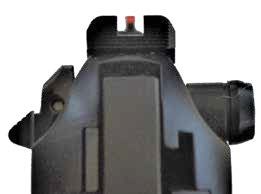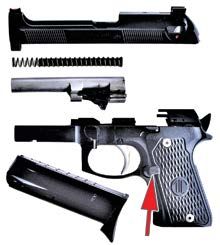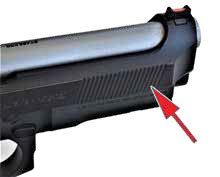The traditional double-action pistol, which generally begins with a long, heavy double-action initial pull then cycles to a lighter, better single-action trigger pull, remains popular. The long double-action trigger press is seen as a safety feature that doesn’t require extra manipulation of the controls. For example, the DA/SA pistol may safely be thrust into the waistband for to-the-mailbox carry or placed beside the bed for defense use. On the other hand, the DA-to-SA trigger action is like the stick shift of modern handguns — some don’t get it, and a legitimate criticism of the handguns is the sometimes difficult-to-manage double-action first-shot trigger.
That said, there have been improvements in the double-action trigger, and we recently tested three compact pistols that promoted some promise of an upgraded initial trigger pull. The trio are arguably among the best choices at a popular price point, around $1000, to just a little more. Our test guns were as follows:
Kriss Sphinx SDP Compact S4-WSDCM-E018 9mm Luger, $999;
Langdon Tactical Technology LTT Beretta 92 Elite LTT-92C-TJ-OP15 9mm Luger, $1184;
and the SIG Sauer P229 Elite-Compact E29R-9-BSE 9mm Luger, $1313.
Firing tests were conducted primarily with Remington UMC 9mm 115-grain FMJ ammunition. We also used a new brand to us Sierra 124-grain JHP, and added the Hornady American Gunner 124-grain XTP. We fired the FMJ loading for combat shooting and all three loads in the accuracy stage.
For the Beretta, CZ, or SIG fan looking for a carry gun to be all it can be, these three pistols should be at the top of the list. We rated the Kriss Sphinx and Langdon Beretta more improved than the SIG P229 Elite over their original factory-delivered templates, largely due to the superlative action job found on each worked-over pistol.
The Langdon Beretta, however, was easily the most elevated action job, over the original 92-Model pistol. A buyer looking for a superior carry gun will find good performance from any of these handguns.
Gun Tests Grade: A (BEST BUY)
$1184
LTT is the company founded by noted competition shooter Ernst Langdon. He has developed modifications and parts for the pistol that make for an excellent all-round defensive handgun. We tested the most popular Langdon Tactical Beretta version with the trigger job and special trigger bar.
| Action | Semi-auto, double action to single action, locked breech |
| Overall Length | 7.75 in. |
| Height | 5.25 in. |
| Maximum Width | 1.5 in. |
| Weight Unloaded | 28.5 oz. |
| Weight Loaded | 35.0 oz. |
| Slide | Steel, Vertec style |
| Slide Retraction Effort | 14.6 lbs. |
| Frame | Steel, compact Vertec with rail; flush mainspring cap |
| Front Strap Height | 2.0 in. |
| Rear Strap Height | 3.0 in. |
| Barrel Length | 4.25 in. |
| Grip Thickness Max | 1.2 in. |
| Grip Circumference | 5.7 in. |
| Magazine | (3) 15 round |
| Rear Sight | Dovetailed square notch, serrated |
| Front Sight | Dovetailed post, fiber optic |
| Sight Radius | 5.6 in. |
| Trigger-Pull Weight Double Action | 8.5 lbs. |
| Trigger-Pull Weight Single Action | 4.5 lbs. |
| Trigger Span Double Action | 2.6 in. |
| Trigger Span Single Action | 2.4 in. |
| Safety | No manual safety |
| Warranty | 2 years, optional extension |
| Telephone | (571) 385-2979 |
| Website | LangdonTactical.com |
| Made In | USA |

The shortened 92G Vertec slide has front cocking serrations, and the G-Model is decock only. The rear of the slide is beveled. The frame begins with an M9A1 shape and adds an exclusive radiused trigger guard, a beveled magazine well, checkering on the front and back straps, and a flush mainspring cap (no lanyard loop). Sights include a dovetailed fiber-optic front (0.110 inch wide serrated) framed inside a square notch serrated rear sight. The stainless 4.25-inch barrel wears a target crown. Other appointments include a solid-steel guide rod, an oversized magazine-release button, a stainless-steel trigger, spurless hammer, stainless-steel hex-head grip screws, and a D-Model hammer spring.
As you can see, the LTT pistol is a much different pistol than the standard Beretta. This pistol is further removed from a Beretta 92A1 Compact than the SIG Elite is removed from a standard P229.

The LTT’s Ultra Thin VZ/LTT G10 grips are excellent. While not quite as comfortable as the SIG P229 Elite’s, they were very nice. This is a considerable improvement over the 92, a pistol many feel is too large for most hand sizes. Larger hands used the magazine rest to support the small finger.
The controls are well laid out. The decock lever is the Beretta 92G version, or decocker only. It does not serve as a manual safety. Many Beretta fans prefer this feature over a safety/decock lever. This keeps the pistol in line with the Sphinx and SIG decock-only handguns. While the Sphinx was rated the easiest decocker to manipulate and the Beretta the most difficult, the LTT was still quite easy to operate. Just use a straight thumb movement, similar to the technique used in moving the 1911-type safety off. The slide lock and oversize magazine release are also models of speed and function.

The wide, smooth trigger is nice and handles better than the standard Beretta. The Langdon Beretta features the smoothest double-action trigger of the test at 8.5 pounds. The single-action trigger is a crisp 4.5 pounds, with a very sharp audible reset. This is the best overall trigger action of the test. The Beretta Vertec slide features forward cocking serrations. The slide serrations are more useful than the SIG’s minimal serrations or the Sphinx SDP’s serrations on its inverted slide. The pistol’s sights are good combat examples, with a red fiber-optic front tube. The grip and grip strap stippling and serrations are well done. The LTT Beretta features a spurless hammer. While it is possible to cock the hammer using the trigger to ease the spur back, we do not recommend doing this. And this technique should not be attempted under stress. The stainless match barrel is nicely crowned. The frame accepts combat lights. The trigger guard is square. Overall, this is a nice package that looks good and feels good.
Firing the pistol for combat accuracy, it is easy to say that there is nothing to be accomplished, tactically, with one of these pistols that cannot be done with the others. Just the same, the smoother Beretta trigger gave the best first-shot hit probability, we believe. When firing quickly, the shooter with the LTT Beretta feels the recoil differently due to the oscillating-wedge lockup. Some may prefer its straight recoil and limited muzzle flip. In bench accuracy, the SIG bested the Beretta, but only by a fraction.
Our Team Said: When everything was figured in, we feel the Beretta is the Best Buy. A match barrel, good sights, and a flawless trigger action all combined for a sterling performance.
Range Data
All groups were fired at 15 yards from a braced benchrest position using an MTM K Zone pistol rest. We used a Competition Electronics Pro Chrony to measure velocity. The first chronograph screen was 10 feet from the muzzles of the firearms.
| Remington UMC 115-grain FMJ L9MM3BC | SIG P229 Elite | Langdon Beretta | Kriss Sphinx |
| Average Velocity | 1110 fps | 1120 fps | 1124 fps |
| Muzzle Energy | 315 ft.-lbs. | 320 ft.-lbs. | 323 ft.-lbs. |
| Small Group | 1.5 in. | 1.7 in. | 1.8 in. |
| Average Group | 1.8 in. | 2.0 in. | 2.2 in. |
| Hornady American Gunner 124-grain XTP +P 90224 | SIG P229 Elite | Langdon Beretta | Kriss Sphinx |
| Average Velocity | 1180 fps | 1166 fps | 1174 fps |
| Muzzle Energy | 383 ft.-lbs. | 374 ft.-lbs. | 379 ft.-lbs. |
| Small Group | 1.7 in. | 2.0 in. | 1.9 in. |
| Average Group | 2.0 in. | 2.4 in. | 2.4 in. |
| Sierra Outdoor Master 124-grain JHP A8124 | SIG P229 Elite | Langdon Beretta | Kriss Sphinx |
| Average Velocity | 999 fps | 1023 fps | 1011 fps |
| Muzzle Energy | 275 ft.-lbs. | 288 ft.-lbs. | 281 ft.-lbs. |
| Small Group | 2.3 in. | 2.5 in. | 2.7 in. |
| Average Group | 2.7 in. | 3.0 in. | 3.4 in. |



























